Trigger Point Therapy for Myofascial Pain (13 page)
Read Trigger Point Therapy for Myofascial Pain Online
Authors: L.M.T. L.Ac. Donna Finando


Trapezius pain pattern
Pain pattern:
Upper fibers:
upper trigger points cause pain along the posterolateral aspect of the neck, behind the ear and possibly to the temple.
Middle fibers:
intermediate trigger points cause pain toward the vertebrae, in the interscapular region and the lateral aspect of the posterior shoulder.
Lower fibers:
lower trigger points refer pain to the neck, suprascapular, and interscapular regions. Pain is accompanied by little restriction of motion.
Causative or perpetuating factors:
Sustained lateral flexion of the head and neck and/or elevation of the shoulders; compression of the upper shoulders; whiplash trauma from the side.
Satellite trigger points:
Supraspinatus, contralateral trapezius, levator scapulae.
Affected organ system:
Respiratory system.
Associated zones, meridians, and points:
Dorsal and lateral zones; Foot Tai Yang Bladder meridian (all yang meridians pass through the fibers of the upper trapezius); SI 12â15, GB 20 and 21, SJ 15, BL 41â49.
Stretch exercises:
- Upper trapezius:
Bend the head toward the unaffected side, pressing the head forward to lift the occiput. Lean the ear toward the homolateral shoulder. While holding this position, grasp the wrist of the arm on the affected side behind the back and pull slightly toward the side of the bend. The muscle on the affected side will receive the stretch. - Middle and lower trapezius:
Sitting in a chair, bend forward, head dropped. Cross each arm over the body to grasp the opposite knee.
Strengthening exercise:
Isometric against mild resistance, the face positioned forward.
- Place the palm heel on the forehead for resistance. Press the head forward, into the resistance.
- Place the palm heel of the right hand on the right temple. Press the head toward the right, into the resistance.
- Place the palm heel of the left hand on the left temple. Press the head toward the left, into the resistance.
- Clasp the hands behind the head just below the crown. Press the head and neck posteriorly, into the resistance.
Hold each position for a count of five.
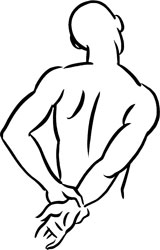
Stretch exercise 1:Trapezius
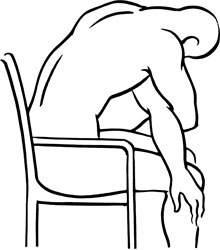
Stretch exercise 2:Trapezius
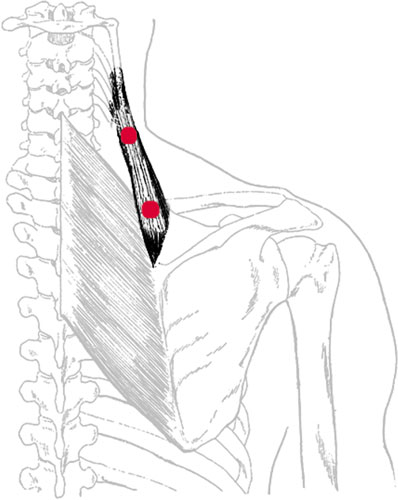
Levator scapulae and trigger points
L
EVATOR
S
CAPULAE
Proximal attachment:
Transverse processes of C1âC4.
Distal attachment:
Medial aspect of the scapula from its superior angle to the root of the spine of the scapula.
Action:
Elevation of the scapula. Assists in rotation of the neck to the same side; can assist in sidebending of the neck.
Palpation:
The levator scapulae is second only to the trapezius in terms of the frequency with which it is beset by muscular constrictions and trigger point activity. The levator scapulae lies deep to the trapezius. As it moves from the superior aspect of the medial border of the scapula to the transverse processes of the cervical vertebrae, it becomes superficial at its middle one-third, which can be palpated directly at the angle of the neck (where the muscle lies between the trapezius and the sternocleidomastoid). Its distal one-third can be palpated through the trapezius when the trapezius is relaxed and when the levator scapulae harbors trigger points or is constricted. In order to differentiate this muscle from the overlying trapezius it is essential to pay strict attention to the direction of the muscle fibers. The fibers of the oblique levator scapulae run vertically and medially, deep to the fibers of the (also oblique) upper trapezius, which run laterally and horizontally.
To locate levator scapulae, identify the following structures:
- Root of the spine of the scapulaâA small, triangular-shaped aspect of the scapula located at the medial border of the spine of the scapula. It most commonly lies on a horizontal line with T3.
- Transverse process of C1âLocate the angle of the mandible, the sharp lateral aspect of the jawbone. Moving posteriorly, the bony prominence of the transverse process of C1, lying between the angle of the mandible and the mastoid process, may be palpated on some people. Palpate bilaterally, gently, as this area may be quite tender.
To palpate the levator scapulae, place your patient in the prone position with his head resting comfortably in a face cradle. It is necessary for the head to be straight, not turned to one side or another, to successfully palpate this region. Your patient's arms should be at his sides with the palms up and the elbows slightly bent.
With your palpating hand, locate the angle of the scapula. Image the direction of the muscle fibers as they angle toward the upper cervical vertebrae. Using a cross-fiber technique, move superiorly back and forth over what you conceive the direction of fibers to be. Levator scapulae becomes superficial at the angle of the neck anterior to the free border of the trapezius.
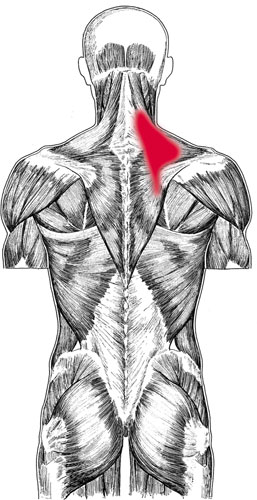
Levator scapulae pain pattern
Pain pattern:
Pain at the angle of the neck and possibly at the posterior aspect of the shoulder and the midscapular region. There will be limited range of motion to the affected side.
Causative or perpetuating factors:
Sustained rotation of the head and neck to one side; emotional tension; early stages of an acute upper respiratory infection.
Satellite trigger points:
Splenius cervicis, scalenes, iliocostalis cervicis.
Affected organ system:
Respiratory system.
Associated zones, meridians, and points:
Dorsal zone; Foot Tai Yang Bladder meridian, Hand Tai Yang Small Intestine meridian; SI 13, 14, and 15.
Stretch exercises:
1.   Bend the head toward the unaffected side, leaning the ear toward the homolateral shoulder. Rotate the face approximately 30 degrees to the unaffected side. Flex the neck slightly, directing the stretch forward and toward the unaffected side.
2.   For a deeper stretch, while holding this position grasp the wrist of the arm on the affected side behind the back and pull slightly.
Strengthening exercise:
Because the levator scapulae is a postural muscle, strengthening exercises are generally not necessary.

Stretch exercise 1: Levator scapulae
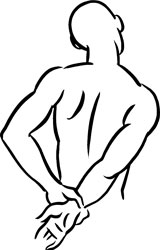
Stretch exercise 2: Levator scapulae
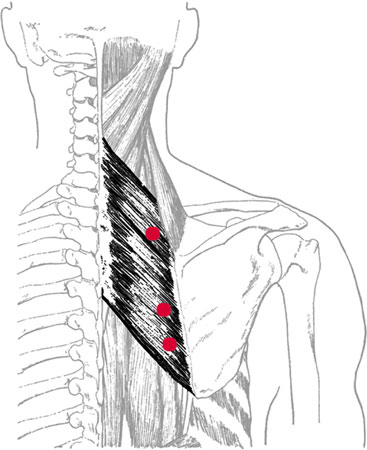
Rhomboids and trigger points
